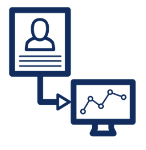Insurance Risk Analytics | What’s new in 2023?
The insurance industry has been utilizing risk analytics for decades to better understand and mitigate risk. With the advent of big data and artificial intelligence, risk analytics has become even more powerful, providing insurers with deeper insights into risk and more accurate predictions of potential losses. But what’s next for insurance risk analytics? In this blog post, we’ll explore some of the key trends and developments that are shaping the future of risk analytics in insurance.
How are insurance companies currently assessing risk?
With the rapid rise of digital distribution, carriers have been caught off guard by the simultaneous rapid rise in risk.
In 2021, 55% of U.S. customers between the ages of 30-49 bought insurance online, and 44% for ages 18-29 — both brackets are expected to increase. That has come with an increase in risk, premium leakage, misrepresentation, non-disclosure, and fraud. Recent studies show that application honesty has deteriorated by nearly 20% in the last decade. As companies continue to accelerate their digital transformations and move their user experiences fully online, it’s easier than ever for risky and fraudulent applications to sneak past their defenses.
With that, it is more important than ever to assess current risk and fraud strategies and deploy the newest and best solutions available to help reduce risk and fraud in a digital world.
Common Insurance Risk Analytics
- Real-time data and analytics: Real-time data and analytics are becoming increasingly important in the insurance industry. With the ability to access and analyze data in real time, insurers can better respond to emerging risks and adjust their strategies accordingly. For example, real-time analytics can be used to monitor weather patterns and predict the likelihood of natural disasters, allowing insurers to take proactive measures to protect policyholders and reduce losses.
- Predictive modeling: Predictive modeling is a powerful tool for insurers, allowing them to more accurately predict potential losses and develop more effective risk mitigation strategies. With the ability to analyze vast amounts of data, predictive modeling is helping insurers better understand the risks associated with their applicants, giving them an edge when it comes to underwriting effectiveness.
- Behavioral Biometrics: Insurers can also use behavioral biometrics to detect fraud. By analyzing an individual’s behavior patterns, insurers can identify suspicious activity, such as account takeover attempts, phishing attacks, attempts to file false claims, or make unauthorized changes to policies.
- Cyber risk analytics: With the increasing frequency and severity of cyber attacks, cyber risk analytics is becoming a critical component of risk management for insurers. By analyzing data on cyber threats and vulnerabilities, insurers can better understand the potential impact of a cyber attack and develop more effective strategies to protect their policyholders.
- Usage-based insurance: Usage-based insurance (UBI) is an innovative approach to risk analytics that is gaining popularity in the insurance industry. UBI allows insurers to price policies based on actual usage data, such as driving behavior or home security systems. By analyzing this data, insurers can more accurately assess risk and provide customized policies for individual policyholders.
Advanced Insurance Risk Analytics for 2023
- Internet of Things (IoT) devices: IoT devices can collect data on everything from driving habits to home security. This data can be used to create personalized risk profiles for individuals and provide insurers with real-time insights into potential risks.
- Blockchain: Blockchain technology can be used to create secure, transparent, and tamper-proof records of insurance policies and claims. This can help insurers reduce fraud and improve efficiency by streamlining the claims process.
- Telematics: Telematics technology can be used to collect data on driving behavior, such as speed, acceleration, and braking. This data can be used to create personalized risk profiles and provide insurers with insights into potential risks.
- Real-Time Intent Data: When a customer submits a digital application, carriers today leverage two main sources of data to underwrite risk. First-party customer-submitted data, which is the information provided by the applicant or agent submitting the policy, and third-party validation data, which is data pulled from third-party sources to verify the information provided. Datasets such as Motor Vehicle Records, CLUE Reports, Credit checks, Rx Data, Medical files, and other data provided by companies like LexisNexis, TransUnion, Verisk, HumanAPI, and more are used frequently during the underwriting process. With real-time behavioral intent data, carriers can leverage a new dimension of data that is captured during the application process and analyzes how a user fills out the application to determine their truthfulness and intent.
Benefits of using risk analytics in insurance
There are several benefits of using advanced risk analytics in insurance. Here are some of the key advantages:
- Improved accuracy: Advanced risk analytics can provide insurers with more accurate assessments of risk, which can help them make better decisions about pricing, underwriting, and claims handling. By using advanced data analytics techniques, insurers can identify risk factors that were previously hidden, leading to more accurate and reliable risk assessments.
- Cost savings: By reducing the incidence of fraud, improving underwriting accuracy, and optimizing claims handling advanced risk analytics can lead to significant cost savings for insurers and customers alike. Insurers can also identify opportunities to reduce costs by streamlining processes, improving efficiency, and reducing waste.
- Personalization: Advanced risk analytics can help insurers create personalized products and services that meet the unique needs of their customers. By analyzing data on customer behavior, preferences, and risks, insurers can create tailored products that are more attractive to their target market.
- Competitive advantage: By using advanced risk analytics, insurers can differentiate themselves from their competitors by providing more accurate risk assessments, better pricing, and more efficient claims handling. This can help insurers attract and retain customers and gain a competitive advantage in the market.
- Improved customer experience: By providing personalized products and services, insurers can improve the overall customer experience. This can lead to increased customer satisfaction and loyalty, as well as increased revenue for the insurer.
- Reduce Premium Leakage, Non-Disclosure, and Misrepresentation: With solutions like ForMotiv, carriers are able to identify instances of premium leakage, non-disclosure, and misrepresentation during the application process allowing for better risk management, more accurate pricing, and an overall improvement to loss ratios.
- Reduce Fraud: Fraud is a massive problem in the industry, to the tune of tens of billions of dollars lost. Accurate risk assessment helps predict fraud so insurers can improve loss ratios and write more profitable business.
Conclusion
In conclusion, the future of risk analytics in insurance is exciting and full of potential. As insurers continue to harness the power of the new tools, solutions, and datasets available to them, they will be better equipped to mitigate risk, protect policyholders, and deliver more value to their customers.






